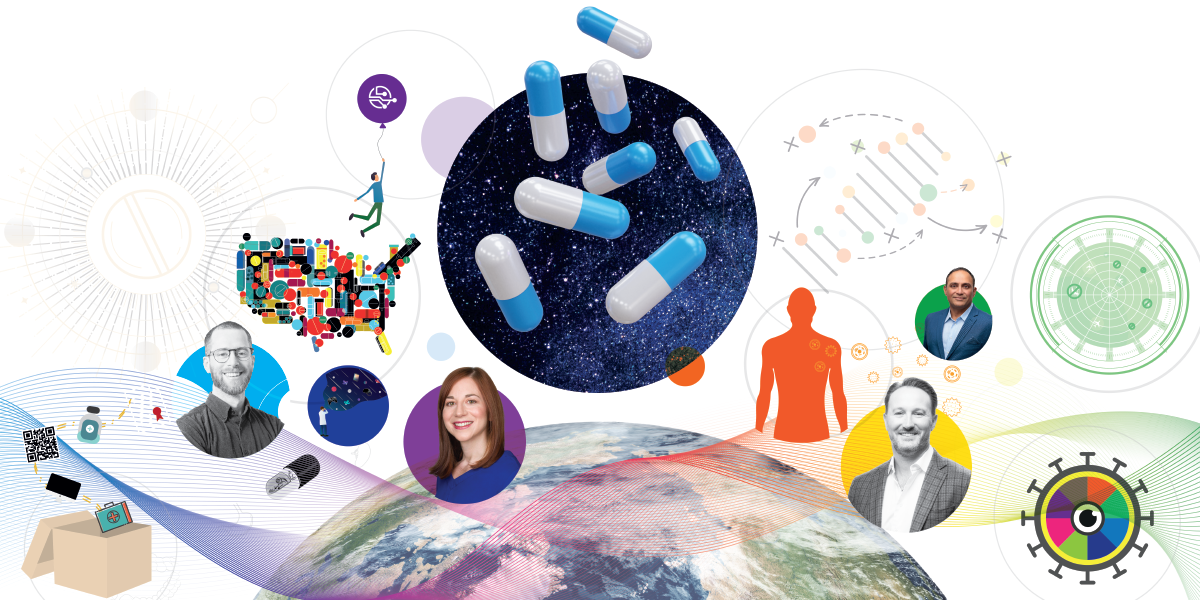The Multifaceted Future of Pharma – Chapter 2: Pushing the Boundaries of Research & Drug Discovery
Here's how next-generation sequencing, protein-prediction tools, CRISPR, and more are yielding breakthroughs in drug discovery.
Next-generation sequencing, protein-prediction tools, CRISPR, and increased knowledge of molecular mechanisms are yielding breakthroughs in drug discovery. Read on for thoughts on current trends, exciting technologies, and what might be possible in the future.
What we asked: “Looking ahead to the next 5–10 years, what will be the key disruptors and/or what can be improved upon in the pharma industry?”

“The Human Genome Project has had an incalculable impact on our understanding of disease drivers and potential therapeutic strategies. Our first read of the genome focused on characterizing the sequence of genes encoding proteins, which provided a roadmap to drug the genome. Armed with this information, our industry has developed an arsenal of therapeutics using multiple modalities that are primarily designed to either inhibit protein function or downregulate the expression of specific genes, including silencing target genes. Despite this progress, we lack deeper insights into the regulation of gene expression to develop a broadly applicable approach to upregulate gene expression and address the more than 1,200 diseases where even a modest increase in gene expression could potentially be transformative for patients.
“In the last decade, technological advancements in next-generation sequencing techniques have provided us with a growing understanding of the mechanisms underlying gene regulation, shining light on a completely new target class for drug development. Through the development of novel approaches and creative applications of proven therapeutic strategies, we have an incredibly vast opportunity to not only to directly address diseases caused by an under expressed gene, but also leverage this newfound capability to advance regenerative medicine as well as disease prevention and health optimization.”
“Digitalization has also revolutionized how the industry operates. Over the past decade, we have seen AI become a cornerstone in drug discovery, helping to identify promising therapeutic candidates much faster. Similarly, modeling and simulation have improved our ability to predict drug performance in humans, while automation is beginning to transform manufacturing processes, ensuring consistent quality and manufacturing efficiency. Remote and virtual disease management has also surged, driven by advancements in mobile technology and accelerated by the pandemic with greater demand for virtual consultations. In the next ten years, these digital innovations will continue to evolve, with AI, automation, and virtual healthcare becoming even more integral to the industry, and making personalized, data-driven care the norm.”

“To truly revolutionize healthcare, the industry needs to move away from the herd mentality that favours the discovery and development of drugs in established areas. We need to rebalance our resources towards novel targets.
“Investing predominantly in known mechanisms – exemplified by the many anti-PD1s in development and the current clustering around GLP1 – creates head-to-head competition, drives down margins, and minimizes the potential for breakthroughs. The number of drug approvals in recent years may have increased, but that is not matched by improved performance for the pharmaceutical sector.
“Industry must be bolder about engaging with breaking science, and act on it sooner, either through direct interaction with academia or by collaborating with partners that operate in novel spaces. Regulatory agencies must go further to smooth the path for new approaches and first-in-class therapies. Breakthrough therapies and those that target smaller patient populations need additional incentives, such as patent term extensions, to encourage true innovation.
“Technological advances offer so much potential that we will not meet if the sector maintains this herd mentality. In an era of the coming of age of AI, novel therapeutic sub-modalities, and a deeper characterization of disease, incremental improvements in patient outcomes should no longer be considered a satisfactory result from the biopharma industry. We need to be aiming for step-change breakthroughs in patient benefit. For that, we need to leave the herd behind.”

“A serious game-changer has been the rise and rapid improvements to AI-based protein structure prediction tools.
“Before these, traditional approaches relied on known protein structures as templates to predict new structures. This was combined with physical principles to predict structures from scratch. However, they often lacked accuracy because of the limited availability of templates and the complexity of protein folding, and struggled with novel proteins. Early iterations of AI tools like AlphaFold, along with competing programs like RoseTTAFold or OpenFold, enabled quicker and easier predictions. Instead of physically trialling a hundred options in a lab, researchers can explore tens of thousands of possibilities in silico.
“The launch of Google DeepMind’s AlphaFold3 in May 2024 has moved the field on significantly. Before, you could make structural predictions of individual proteins and interactions, but the new version now allows you to predict interactions between proteins and ligands, or all kinds of other biomolecules. With the ever-increasing computing power of these tools, we will be able to predict and understand the structural and functional interactions of cellular components, which will directly lead to a new understanding of drugs, drug targets, and off-target interactions of drugs, precisely predicting drug effects and side effects.
“Ten years ago, we dreamed of predicting the structure of a protein. Now, we can predict interactions between proteins and different molecules. In ten years’ time, maybe one will be able to build a structural model of a whole cell or an organ with all its interactions. This will open up whole new insights into drug development.”
“Our healthcare system must recognize that many diseases have multiple molecular subtypes, with distinct pathways that may lead to the same disease but respond differently to specific treatments.
“Disease diagnosis is driven by identifying groups of symptoms described by patients and what physicians can infer from their test results. These observations, which provide only very broad information about individual patients, are categorized into groups called diseases. Such categorization is convenient for physicians and may provide some comfort to patients, but the process lacks key information that would allow precise targeting of the molecular changes driving the health problems. Understanding the molecular basis of patients' current conditions and the molecular mechanisms behind their development has the potential to enhance all treatment decisions – an approach that has yielded profound advancements in oncology therapeutics.
“Over the past decade, the oncology community recognized the molecular nature of disease, leading to the development of superior therapies. Drug companies must now extend this approach to other disease groups beyond cancer. This strategy will bring many benefits but also additional requirements, including the collection of molecular data before major symptoms appear and the testing of molecular therapies tailored to specific disease subtypes.
“Targeting better-defined patient groups reduces heterogeneity in clinical trials, leading to more significant results and smaller, less expensive trials. Limiting treatment to those subgroups expected to respond reduces the overall risk of side effects by avoiding the potential for a drug that benefits one subtype to harm another. Finally, a molecular diagnosis provides a clear therapeutic pathway for both patients and their physicians.”

“CRISPR-based genome editing technologies have emerged as a profound and key disruptor. CRISPR represented a significant step towards realizing the full potential of genetic medicines, but innovation cannot stop here. CRISPR has evolved to efficiently cut DNA and can be thought of as molecular scissors. However, as a genome editing tool, it is best suited to address diseases for which a gene needs to be turned off, rather than fixed to restore function. The genome engineering toolbox of tomorrow will enable virtually any genetic change needed to treat human disease, from precisely introducing single nucleotide changes to inserting exons or whole genes into the genome.
“As the industry collectively strives to solve the current limitations associated with genome engineering, the next decade is poised to be defined by the advent of genome editing tools that enable a broad range of edits. This leap forward promises to become a new pillar of genetic medicine, offering hope for curing previously intractable genetic disorders and imparting protective genetic changes to prevent common diseases on an unprecedented global scale.”

“Despite the implementation of many effective R&D strategies, a high percentage of clinical drug development candidates continue to fail. With the rise of complex therapies including immunotherapies and ATMPs, it is essential that we employ new technologies to improve and accelerate translation from lead optimization through preclinical and into successful clinical development.
“In multifactorial disease settings including cancer, CNS and autoimmune disease, there is a reliance on long established in vitro and (expensive) in vivo models that do not necessarily reflect complex disease biology. Development of new, higher throughput 3D organoid models that are specific to disease settings may facilitate the screening of more compounds and increase the probability of successful translation.
“In addition, earlier identification of biomarkers through bioinformatics and clinical analysis may lead to better identification of ‘sensitive’ patient sub-populations. Improved efficiency of translation will subsequently result from acceptance of realistic expectations regarding the predictive validity of animal models.”
“One of the biggest changes I think we’re going to see within the drug discovery and development sector over the coming years is that emerging tools, such as next-generation in vitro models, will really start to take center stage. It’s not going to be a “revolution” as some expect, completely replacing the need for animal models, but a gradual uptick in the use of in vitro approaches. We’re seeing this today in many respects – new legislation and increasing publication of in vitro data is leading to growing confidence in these models to provide accurate and reliable data that can, and should, be used to support regulatory submissions.
“We’re already at a stage where in vitro models have become powerful tools for obtaining physiologically relevant insights during early-stage drug discovery and development, and in some cases are already embedded in common workflows. In efficacy studies, for example, when researching diseases that have a genetic basis, we can use stem cell technology to accurately mimic complex, 3D tissue structures and study distinct aspects of the disease in a much more successful way than we can often achieve using animal models.
“Perhaps the most important driver to this step change will be the accumulation of a critical mass of publications and datasets demonstrating that in vitro models have been used to successfully progress therapeutic candidates into the clinic and market. This will be the tipping point where we will start to see widespread acknowledgement of the transformative potential of these new approach methodologies.”

“To perform its function, a given cell utilizes a plethora of various molecules organized in subcellular structures. The challenge of drug development lies in the fact that those molecules act in ways that are highly cell type and context dependent. This means that the same type of interference with the same molecule leads to multiple, unpredictable, and often undesirable effects. The problem is compounded by the molecular complexity of cellular regulatory pathways, which makes the “one disease–one drug” paradigm unlikely to succeed in diseases outside of Mendelian genetic disorders. Drug combinations and multi-specific biologics scratch the surface, but are not enough.
“The most meaningful biologic, and thus therapeutic, effects can be achieved in the context of cells whose deregulation underlies the disease pathophysiology.
“There are two solutions: highly specific drug delivery and cellular therapy. The highly specific approach has a long way to go and is unlikely to address the challenge of biologic complexity. In contrast, cells can be pre-modified in multiple ways with various molecular and genetic tools before reintroduction into the body. This opens up multiple and seemingly unrestricted opportunities for all current approaches complemented by synthetic biology and, yes, by AI, too.
“In spite of the remarkable efficacy of relatively unsophisticated, recently approved cellular therapeutics, such as CAR-Ts, the industry (and especially investors) considers the necessity of dealing with cellular products a temporary annoyance. Wider realization that the expertise and infrastructure required for delivering cellular products to patients opens up unlimited opportunities, and provides a huge competitive advantage, will mark a revolutionary transition for the industry.”

“One of the enduring rate-limiting factors in R&D is the identification of new biological targets and novel modalities to effectively drug them. In recent years, mRNA-based medicines have risen to the forefront of the industry, offering the ability to prospectively design and engineer therapeutics that work within the natural cellular processes to control physiology with exquisite precision. In parallel, we’ve developed a deeper understanding of how gene expression is regulated by epigenetic marks. Combining an mRNA-based approach with the science of epigenetics yields a tremendous opportunity to create the next leading therapeutic class and transform drug discovery efforts and the pharma industry as we know it.
“Programmable epigenomic mRNA-based therapeutics enable specific, tunable, and durable modulation of gene expression without altering DNA sequences. This unprecedented level of precision allows for more effective and targeted treatments, reducing potential side effects and increasing therapeutic efficacy. Moreover, these therapeutics are adaptable to various delivery methods, enhancing their versatility and applicability across different therapeutic areas.
“A notable advantage of this technology is its potential to regulate the expression of nearly any gene, including those previously deemed undruggable by other modalities. This capability vastly expands the list of available targets and opens exciting avenues for treating a wide range of genetic disorders, cancers, and chronic diseases that have long eluded effective treatment.”

“To improve drug discovery, we must break the host immune barrier for protein, gene, viral and cell therapeutics. The immune system is a crucial source of modern medicines, but it also poses significant challenges by creating an "immune barrier" that complicates the delivery and efficacy of protein, gene, viral, and cell-based therapies. The clearest and most pervasive barrier is the anti-drug antibodies (ADA). ADA reduces drug exposure, inhibits therapeutic activity, and in many, can cause frequent infusion reaction and anaphylaxis. Antibodies against viral vectors limit options for vaccine development and gene therapy delivery. ADAs against cellular transplants can jeopardize the persistence of transplanted cells, whether they are stem cells or T cells. Further, ADAs can significantly hinder drug development by rendering efficacy, pharmacokinetic, and toxicity data from preclinical models less relevant to future clinical studies.
“Until now, the problem has been widely acknowledged but there has been little progress because of a lack of effective solutions. Broad immune suppression has been attempted but proved ineffective and undesirable because it increases the risk of infection and malignancies. A breakthrough in overcoming the ADA induction is called for, which would not only improve efficacy and safety of therapeutics across oncology and autoimmune indications, but importantly, would broaden patient access.”
“The single change that could dramatically improve the pharma industry will be the ability to design, develop, and commercialize therapeutics based on glycobiology. Glycans represent a major posttranslational modification of cell membranes, proteins, lipids and carbohydrates which serve as an energy source, a structural component of cells and organisms, and – more importantly – as the central signaling modulator of the innate and adaptive immune system.
“Simple sugars and complex sugar patterns cover every living cell and numerous macromolecules, serving as immune identifiers. These sugar coatings can be likened to QRS codes. The immune system has sugar pattern recognizing receptors (QRS code reader) that program the immune fate of cells and direct disposition of macromolecules. Think Amazon warehouse.”
“The glyco-QRScode for inflammatory resolution has been partially cracked by deciphering the binding characteristics of immune resolving receptors called Siglecs,(QRScode reader) a family of receptors differentially expressed on all activated immune cells. These readers recognize unique sialic acid QRS codes that resolve activated immune cells. The complexity of sialic acid patterns combined with the differential expression of Siglecs, represents the sleep or shutdown code for both individual immune cells and the immune system as a whole. Succesfully binding these receptors resolves inflammation while allowing for immune homeostatic healing and maintenance functions, like software running in sleep mode that keep your computer running smoothly.”
“Many prevalent debilitating disease conditions result from either a failure to resolve inflammation or a failure of immune clearance. By mimicking these sialic acid sugar patterns(glyco-QRScodes) and presenting them to the immune system appropriately, diseases of immune overactivation can be resolved. Inflammatory resolution and neuroprotection can also be enhanced to regain function in neurodegenerative diseases, such as macular degeneration without immunocompromising side effects”
“The potential of translating this glyco-code into profoundly effective but extremely safe therapies that can precisely modulate the inflammatory system and restore immune healing function has the potential to revolutionize the pharma industry. Understanding the biological role that sugars play in immune modulation and cellular regeneration will accelerate the next era in pharma: the Glycomic Revolution.”
“Over the past decade, the pharma industry has been transformed by significant advancements in our ability to engineer, deliver, manufacture, and read biology within an increasingly tech-enabled and evolving regulatory framework. These innovations have led to more rapid, personalized, and safer delivery of patient care. For instance, the democratization of next-generation sequencing, proteomics, and liquid biopsies has advanced the healthcare system by enabling more patient-specific diagnoses and treatments. Among these advancements, liquid biopsies stand out for their ability to non-invasively detect diseases at their molecular level.
“Liquid biopsy, coined in 2010 as an alternative approach to tissue biopsy, became a viable method for cancer detection with the realization that tumors shed specific molecular information such as DNA into the bloodstream. This discovery raised the potential to detect emerging cancers with a blood draw via circulating tumour cells (CTC) or circulating DNA mutations (ctDNA). However, despite an industry pivot towards DNA methylation patterns, detecting early cancer stages has remained a biological challenge. Meanwhile, another major liquid biopsy modality was emerging: extracellular vesicles (EVs).
“EVs are diverse, membrane-bound vesicles continuously secreted by cells, transporting biological cargo such as DNA, RNA, proteins, lipids, and metabolites. Their content mirrors the cell's health status and is protected from enzymatic destruction. Additionally, EVs are abundant at any stage of health or disease and contain tissue-of-origin markers, making them ideal for liquid biopsy.
“But beyond diagnostics, EVs show promise as natural drug delivery vehicles. In regenerative medicine, native mesenchymal stem cell-derived EVs can promote tissue repair and modulate immune responses without the standard manufacturing challenges of cell therapies. Additionally, EVs can aid in identifying novel disease-related cellular pathways in drug discovery. Aside from cancer, EVs hold great potential in addressing a broad spectrum of diseases from cardiovascular and metabolic to neurodegenerative disorders.
“Looking ahead, as technological innovations converge, EVs are well positioned to become one of the key biotech disruptors in the next 10 years.”

“In parallel with the expanding field of genomics, it has become evident that the complexity of the human proteome far surpasses that of the genome. It is estimated that the number of proteins expressed by our 20,000 genes is potentially in the hundreds of thousands. Distinct protein isoforms, called proteoforms, result from post-transcriptional mechanisms, such as alternative RNA splicing, and post-translational modifications including phosphorylation. While these mechanisms produce physiologically normal proteoforms, when disrupted, they can result in the expression of aberrant proteoforms with a role in a wide range of diseases. For example, a proteomics study evaluating KRAS4A and KRAS4B, isoforms of KRAS – one of the most frequently mutated oncogenes in human cancer – revealed 39 proteoforms identified in colorectal cancer cell lines and primary tumor samples. In a separate study, the tumor suppressor protein PTEN was shown to exist in several different proteoforms. These proteoforms represent possible targets for drug development.
“Given the opportunity of finding a wealth of new drug targets among protein variants, there is a pressing need to identify all healthy- and disease-associated proteoforms. Next-generation protein sequencing enables identification of unknown proteins that are critical to both normal and disease biology. The technology is particularly useful for understanding single amino acid variations, post-translational modifications, and protein characteristics that are especially difficult to analyze with mass spectrometry or antibody-based techniques.
“Today, use of next-generation protein sequencing is advancing and accelerating the understanding of complex diseases by delivering a more detailed view of the vast array of proteins and their variants. Just as the field of genomics paved the way for new therapeutics, a more complete understanding of the universe of proteoforms has the potential to lead to a wealth of new drug candidates and precision-targeted novel therapeutics with greater efficacy.”

“Over the past decade, the drug development landscape has experienced transformative shifts, particularly with the advent of sophisticated discovery platforms and advanced molecular imaging technologies that enable the high-definition visualization of important cellular targets of interest. One example, Cryo-Electron Microscopy (CryoEM), has revolutionized R&D efforts, enabling scientists to visualize molecular and cellular structures at near-atomic resolution.
“Detailed images of biological molecules in their native states have been a game-changer in drug discovery, empowering researchers to leverage an in-depth understanding of the critical relationship between structure and function for complex biomolecules. The availability of atomic-level information coupled with powerful computational tools allows drug discovery scientists to design and optimize hits and leads for a broader range of therapeutic targets, including traditionally more challenging ones such as membrane bound proteins.
“As we look to the future, the next decade promises even greater advancements. The integration of AI and ML with these technologies is poised to further refine our ability to prospectively design novel therapeutics. This synergy will not only optimize the drug discovery process but also unveil new therapeutic targets for complex diseases.”

Advances in targeted protein degradation and the development of molecular glue degraders has been a key disruptor in the biopharmaceutical industry. Targeting the ubiquitin-proteasome pathway to selectively degrade disease-associated proteins, these technologies have transformed drug discovery and therapeutic strategies.
The advent of bivalent degraders, such as proteolysis-targeting chimeras (PROTACs), has marked a major milestone. Degrader-based drugs exploit the TPD pathway by recruiting E3 ligases to a protein of interest, eliminating them from cells in a highly efficient catalytic process. This approach has garnered considerable interest, leading to an increase in disclosed degrader drugs and clinical trials. Despite this progress, challenges in medicinal chemistry and bioavailability remain, driving research to expand the range of E3 ligases that can be recruited for degradation.
The next decade promises further innovation, particularly with the rational design of molecular glues. Unlike bivalent degraders, these are monovalent and work by stabilising interactions between an E3 ligase and a protein of interest, facilitating degradation. Although the rational design of these degraders has proved challenging, breakthroughs are anticipated as platforms to overcome the difficulties in discovering this class of molecule are developed – providing a systematic discovery approach to address therapeutic targets. Technologies such as cryo-electron microscopy and machine learning will play a crucial role in elucidating the mechanisms and optimising their design.
Molecular glues offer a number of advantages, including overcoming some of the pharmacokinetic limitations of bivalent degraders and expanding the druggable space to previously undruggable targets. This modality holds particular promise in oncology by facilitating cancer-specific degradation, minimising off-target effects and ultimately improving therapeutic outcomes.
